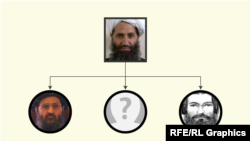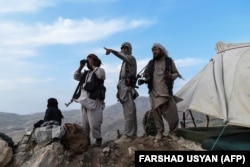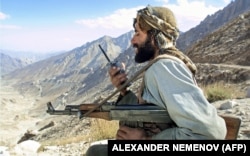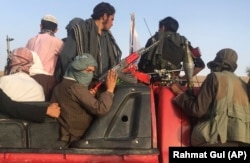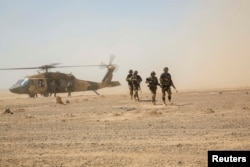With the Taliban in control of more than half of all districts in Afghanistan, promises made by Taliban political negotiators in Doha appear to be falling by the wayside.
The movement’s so-called Political Affairs Commission in Doha had vowed in a February 2020 peace deal with the United States that the Taliban would respect human rights and keep foreign fighters out of the territory it controls.
But recent reporting by RFE/RL’s Radio Azadi and Tajik Service belies Taliban claims that it has no foreign fighters in Afghanistan, as there are thousands of them -- mostly Pakistanis -- fighting under the Taliban banner.
Meanwhile, Human Rights Watch said Taliban militants who’ve recently advanced in Ghazni, Kandahar, and other Afghan provinces have been detaining and summarily executing soldiers, police, and civilians with suspected ties to the Afghan government.
Such reports raise doubt about how much clout, if any, the political office in Doha has over battlefield commanders and the shadow governors that Taliban military leaders have installed in the territories they control.
“The most important question about Taliban command and control is the one we know the least about right now,” Afghan security analyst Ted Callahan said. “It centers on the Taliban in Doha right now who are negotiating with the Afghan government and to what degree they actually control the fighting on the ground.”
Command And Control
Questioned by RFE/RL, Taliban spokesman Zabiullah Mujahid described a leadership structure in which the Political Affairs Commission in Doha has no direct control over the fighters who’ve seized vast tracts of territory in recent months.
Mujahid explained in an e-mail to RFE/RL that the Doha political office is just one of nearly two dozen commissions and offices that serve as a kind of cabinet of ministers beneath Taliban Supreme Leader Malawi Hibatullah Akhundzada.
Mujahid said a separate branch in the Taliban’s leadership structure -- the Military Affairs Commission -- oversees the movement’s entire military chain of command down to the provincial and district levels.
He said Akhundzada is the Taliban’s “ultimate authority” on religious, political, and military issues -- adding that Akhundzada has three deputies under his command.
Political Affairs Deputy Mullah Abdul Ghani Baradar heads the Political Affairs Commission and leads the Taliban negotiating team in Doha.
The deputy leader for southern provinces, Mullah Mohammad Yaqoob, is the son of the late Taliban founder Mullah Mohammad Omar. He also heads the Taliban’s military operations.
Akundzada’s deputy for eastern provinces, Sirajuddin Haqqani, also is the head of the so-called Haqqani network.
Mujahid noted that the Taliban’s military chain of command falls under the Military Affairs Commission, which is dominated by Yaqoob and Haqqani.
Going up the chain of command from the district level, each Taliban battlefield commander answers to a provincial command.
Mujahid told RFE/RL there are seven regional “circles” that are each responsible for at least three provincial commands.
Finally, overseeing those regional “circles” are two deputy leaders of the Military Affairs Commission. One is in charge of 21 provinces in the Taliban’s so-called “western zone,” Mujahid said. The other oversees the command in 13 provinces in the “eastern zone.”
The Taliban’s Military Affairs Commission also is responsible for appointing and overseeing all of the provincial and district “governors” in the Taliban’s shadow government.
Necessary Evolution
Analysts say the Taliban’s current leadership structure has evolved out of necessity since 2001 from a loose-knit organization of local militia commanders into a more organized political and military movement.
The key leadership changes came in a response to a dispute that divided the Taliban into rival factions following the death of Taliban founder Mullah Omar in 2013.
In fact, those divisions are an extension of a long-running power struggle based on Pashtun tribal structures.
One side backed Omar’s son as the Taliban’s next supreme leader. It has followers in western and southern Afghanistan. It also dominated the Taliban’s highest advisory and decision-making leadership council -- the Rahbari Shura -- which is better known as the Quetta Shura.
On the other side are Taliban commanders in eastern Afghanistan and Pakistan linked to the Haqqani network. It has strong links to consultative leadership councils known as the Peshawar Shura in northwestern Pakistan and the Miran Shah Shura in Pakistan’s North Waziristan tribal region.
A 2019 study by the U.S. Institute for Peace (USIP) described how the Taliban refined its command structure after the death of Mullah Omar to smooth over the factional divisions.
It said that by creating a more unified military and political movement, the Taliban has been “able to capture and govern large stretches of territory.”
To do so, it created the system of shadow Taliban governance -- a move that allowed military commanders from different factions to appoint shadow government “officials” in territory under their control.
Still, Taliban shadow governance has been “uneven and ad hoc,” the USIP study concluded. It produced different rules “shaped by individual commanders’ preferences, local traditions, and the Taliban’s strength in the community.”
“Multiple actors -- from the Taliban leadership to local commanders -- have played a key role in creating and shaping the movement’s policy in Afghanistan,” it said. “Taliban policymaking has been top-down as much as it has been bottom-up, with the leadership shaping the rules as much as fighters and commanders on the ground.”
Callahan said a key question impacting Afghanistan’s future is whether, going forward, the Taliban will be able to maintain its current command-and-control structure.
“Will it strengthen or will it decentralize so that we see Taliban fiefdoms which are much more regionally aligned than they are nationally?” asked Callahan.
Today's Taliban
“If you had to put a very simple label on it, the Taliban are now basically disgruntled Afghans,” Callahan told RFE/RL. There also are thousands of non-Afghan Taliban fighters in the country, he added.
“It’s no longer a Pashtun ethno-nationalist movement,” Callahan explained. “It’s much more diverse than it was in the 1990s.”
Bill Roggio, a senior fellow at the U.S.-based Foundation for Defense of Democracies (FDD), doesn’t believe the Taliban’s promises in the 2020 Doha agreement to respect human rights and keep foreign fighters out of the territory it controls.
Roggio, a senior editor of the FDD’s Long War Journal, said today’s Taliban still appears to be trying to establish an Islamic Emirate of Afghanistan and impose their strict version of Islamic law on the Afghan people.
But Roggio also sees important differences between today’s Taliban and the Islamist regime that controlled most of Afghanistan during the late 1990s.
“The Taliban is largely made up of Afghans,” Roggio told RFE/RL. “It’s dominated by Afghans. But this question is a little tricky because of groups like the Haqqani network that are based in both Pakistan and Afghanistan.”
“There are a large number of ethnic Uzbeks and Tajiks, even Turkmen and, in some cases, even ethnic Hazara who are Afghans and are part of the Taliban today,” Roggio said. “The Taliban has made deep inroads into these communities in recent years. That’s a big different between the Taliban today and the Taliban before the September 11, 2001, terrorist attacks against the United States.”
The thousands of foreign militants fighting for the Taliban in Afghanistan include fighters from the Middle East who are part of Al-Qaeda as well as militants from Pakistan and Central Asia, he said.
Indeed, a recent report by the UN Security Council’s Analytical Support and Sanctions Monitoring Team said that out of an estimated 85,000 active Taliban fighters in Afghanistan, about 10,000 are thought to be foreign militants.
It says about 6,500 of them are Pakistani citizens. It says others come from Central Asia, Chechnya, or the remnants of Al-Qaeda in the Middle East.
“The primary component of the Taliban in dealing with [Al-Qaeda] is the Haqqani network,” the UN monitoring team concluded. “Ties between the two groups remain close, based on ideological alignment, relationships forged through common struggle, and intermarriage.”
In northern Afghanistan, an exclusive report by RFE/RL’s Tajik Service documented how the Taliban has put the commander of militants from Tajikistan in charge of five districts recently seized by the Taliban along the border with Tajikistan.
The 25-year-old commander, who goes by the alias Mahdi Arsalon, was born in the village of Sherbegiyon in Tajikistan’s eastern Rasht Valley.
Arsalon and his militants are known in Afghanistan as the “Tajik Taliban.”
In reality, they are members of Jamaat Ansarullah, a group founded a decade ago by a rogue former Tajik opposition commander with the goal of overthrowing the government in Dushanbe.
Jamaat Ansarullah is banned in Tajikistan as a terrorist group.
RFE/RL correspondents in northwestern Afghanistan recently reported the presence of Uzbek militants affiliated with the banned Islamic Movement of Uzbekistan (IMU).
Badghis Province Governor Hossamuddin Shams told RFE/RL the Uzbek militants have been managing the Taliban war in parts of the north and west of the country.
Shams said the families of about 80 Uzbek militants arrived in Badghis Province from Pakistan in 2018 and are now stationed in the Bala Murghab district.
He said most of these Uzbek Taliban fighters are the children of IMU militants who fled to Pakistan in late 2001 after they helped the Taliban fight against the anti-Taliban Northern Alliance the previous year in Takhar Province.
Afghanistan’s northern neighbors say they are concerned that Central Asian Taliban fighters will eventually try to return to their homelands to launch insurgencies.
Callahan, a former adviser to U.S. Special Forces in northern Afghanistan, said the Taliban’s claim that it does not have foreign fighters in its ranks is “demonstrably untrue.”
“It does seem that they are using these fighters simply because they lack the manpower at the moment to administer all of the areas that they’ve taken over,” Callahan told RFE/RL. “That seems to be a consensus point right now.”
“In the Taliban blitzkrieg across the north in recent months, there are reports of foreign fighters actually being involved in the fighting because, in many cases, the Afghan and Pakistani fighters were insufficient in numbers,” he explained.
Callahan notes that reports of ethnic Uyghur militants from western China being used by the Taliban in the northeastern Afghan province of Badakhshan have unsettled Beijing.
He said the Taliban will continue to deny the presence of foreign fighters among its ranks.
“There is a potential future role in Afghanistan of China,” he said. “Beijing seems to be hedging its bets on whether the Afghan government or the Taliban will have power in the future. They seem poised to work with either group.”
“Having foreign fighters who work with the Taliban -- particularly Uyghur militants -- does threaten the Taliban-Chinese relationship in the future,” he concluded.
Taliban Vs. Afghan Security Forces
On paper, the Taliban is heavily outnumbered and technologically inferior to Afghanistan’s National Security Forces.
But analysts warn that, as with many things about Afghanistan, what appears on paper is not as it is on the ground.
Including troops under the command of the Defense Ministry and police in the Interior Ministry, there are at least three times as many Afghan security forces than the estimated number of active Taliban fighters in the country.
The U.S. Special Inspector General for Afghan Reconstruction (SIGAR) said in its latest report to Congress that the total strength of Afghan National Security Forces -- including the army, special forces, the air force, police, and intelligence officers -- is about 307,000 personnel.
Jonathan Schroden, a security expert at the CNA research organization in Arlington, Virginia, estimates that the Afghan government has about 180,000 available combat troops on any given day.
Afghanistan also has been well supplied by the United States, which has spent some $83 billion to help build, equip, train, and sustain the Afghan security forces since the previous Taliban regime was toppled in late 2001.
Afghanistan’s military has received armored vehicles, planes, and attack helicopters, artillery, assault rifles, night-vision goggles, and surveillance drones from the United States.
SIGAR said the Afghan military also has a fleet of 167 aircraft, including its attack helicopters.
But the weaponry delivered to Kabul over the past two decades and what is now available for combat are two different things.
Complete details about the current status of the Afghan arsenal are classified.
But anecdotal evidence suggests much of what has been delivered to the Afghan government and pro-government militias over the years is either no longer functioning or has fallen into the hands of the advancing Taliban.
Roggio and Callahan agree that the main source of Taliban weaponry appears be within Afghanistan itself.
They say that includes recently captured Western-made weapons and equipment that was supplied to the Afghan military such as assault rifles, vehicles, and night-vision goggles.
It also includes the small arms and light weapons that flooded the country since the Afghan-Soviet War in the 1980s, such as Soviet-designed AK-47 assault rifles, rocket-propelled grenade launchers, and mortars.
Taliban expert Antonio Giustozzi said the Taliban have tried to use some antiaircraft and antitank weapons with mixed success.
Small rockets, suicide bombers, and improvised explosive devices (IEDs) are among the deadliest weapons used by the Taliban.
Experts say the regional black market also is a rich source for Taliban weaponry.
Chemicals for fertilizer brought from Pakistan are known to have been widely used by the Taliban to make IEDs in southern and eastern Afghanistan.
But officials in Pakistan, Iran, and Russia deny accusations by Kabul and the U.S. military that they have covertly supplied Afghanistan’s Taliban with weapons and other support.
Written and reported by Ron Synovitz in Prague with reporting by RFE/RL Radio Azadi correspondents in Afghanistan whose names are being withheld for security reasons. Additional reporting by RFE/RL’s Tajik Service.





